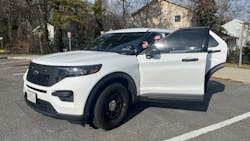For decades, police recruits have learned what parts of a patrol vehicle will actually stop bullets (cover) as compared to which parts only hide you from view (concealment). Over those decades, law enforcement patrol and specialty vehicles have evolved in their design. Sedans went from the full-size vehicles of the 1970s and 1980s (think Impala, Crown Victoria, Diplomat and others) to the more recent patrol sedans that are mid-size (think Taurus and Charger). With the change of overall size, was there any change in the available cover? Certainly, it’s easy to see that the amount of concealment was reduced with the overall size of the vehicle.
This article appeared in the January/February issue of OFFICER Magazine. Click Here to subscribe to OFFICER Magazine.
Taking that a step further, when SUVs and pickup trucks became more widely used for patrol and special duty purposes, was the same consideration given to teaching the available cover with them? For the purpose of this article, we decided to take a look at the more common patrol vehicles—specifically the Ford Police Interceptor Utility (based on the Explorer SUV), the Ford F-150 Police Responder (pickup truck) and the Dodge Durango Pursuit SUV. Dodge discontinued the Charger sedan after 2023 and (as this is written) the Ford website no longer shows a sedan police model. It appears that law enforcement is going all SUV or pickup truck for 2024 (we’ll leave electric vehicles out for now).
First off, let’s recognize something every officer and deputy should already know: The movies lie. Car doors are not bulletproof. Yes, they can and do certainly slow down bullets, but if a car door stops a bullet, it’s by chance, not by design. They will slow down the projectiles, but not enough to be safe on the other side. Those bullets that just zoomed through vehicle doors can still (easily) hurt or kill you.
Interestingly, while you can’t count on the windshield to deflect bullets, the movies lie about just how easy it is to shoot through a windshield as well. When shooting through that tempered safety glass, the best chance of penetration is with a shot as close to perpendicular to the glass as possible. The greater the angle of shot approach, the greater the chance the bullet won’t penetrate.
Secondly, let’s recognize that metallurgy changes and can have a huge impact on how much cover is offered by a given piece. For instance, a steel engine block can provide good cover, but an aluminum frame piece on a truck nowhere near as much. Sheet steel will not stop bullets, but multiple layers with other materials in between can… maybe. Don’t bet your life on it.
As to the question of what does or doesn’t provide cover in a patrol vehicle, there’s a long and a short answer. The short answer is: The engine and the wheels will likely stop incoming rounds. Obviously, that depends on what caliber the projectile is, how far it has traveled, what angle it’s coming in at, etc. So many factors impact terminal ballistics (when the bullet hits a target) that there are no guarantees. You can count more on the engine and wheels to be cover than any other part of the vehicle.
The much longer answer is this:
If there’s enough vehicle between you and the incoming round, then the vehicle can be cover. A single vehicle door? No. You can’t count on that. The storage area of the back of your patrol SUV, which is full of gear and equipment? The bullet likely won’t traverse the entire width of the vehicle from outside to outside and passing through a fully stocked storage compartment. But using that section of your vehicle as cover requires you to know what is in there.
It’s important to understand and appreciate that ANY cover is better than no cover, and if parts of the vehicle can slow the rounds down before they get to you, then that’s always a good thing. If you can’t position yourself behind the engine, or behind the wheels, then just get as much of the vehicle between you and the bad guys as you can. The SUV from front left corner to right rear corner is a lot of vehicle. It’s a lot of metal, plastic, alloys, fabrics, etc. to stop, slow or deflect a round.
It’s equally important to remember that your position makes all the difference and if you’re not careful it’s easy to leave body parts exposed, without cover or concealment. Standing on one side of your vehicle might hide you some, especially if you bend over to be behind the door(s) or vehicle body. But are your feet protected from anything? The vehicle doesn’t go all the way to the ground, so could bad guys shoot under it and hit you in the ankles or feet?
Studying the challenge shows that vehicle position in relation to the potential threat and your position within the vehicle play the largest role in how much cover you’re going to get in or around said vehicle. When you start looking at the combination of positions and thinking about yourself in the driver seat, canting the vehicle slightly left behind a suspect vehicle means you get more of the engine between you and it. However, if you’re in the passenger seat of the SUV, that positioning provides distinctly less cover. If your vehicle is positioned sideways (perpendicular) to the potential threat, you want to be using the engine compartment as cover. Sure, the rear storage compartment might provide you cover, and it should be considered an option, but not if it’s empty. Unless you have a significant amount of gear in your storage compartment, hopefully some of it metal, you can’t use that area as cover.
Let’s touch on pickup trucks just briefly. The truck bed, unless it’s full of hard gear, isn’t cover. It is effectively a thin-sided empty box. That leaves the engine compartment and wheels to be used as cover. Also, typically, pickup trucks sit up higher from the roadway, exposing more of your legs, ankles and feet below the metal body of the vehicle.
In this article, where you’ve read “wheels,” remember that we’re not talking about the tires. Tires are rubber, even if the treads are backed by metal or other material strands or cables, but the sidewalls are much thinner rubber and typically won’t stop bullets. Off-road tires, with their typically thicker construction all around, will do a better job of slowing down incoming projectiles but should not be considered cover.
Next time you sit down in your patrol vehicle, stop and look around. Consider your position, the equipment in your vehicle, what’s in the storage area in the back, etc. Where is cover available to you?



